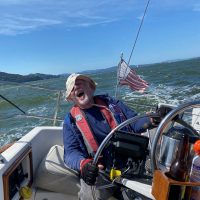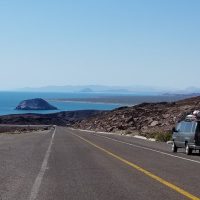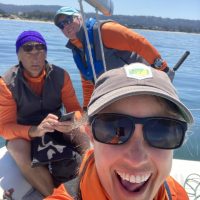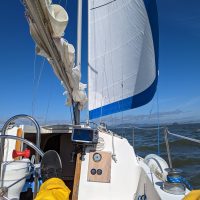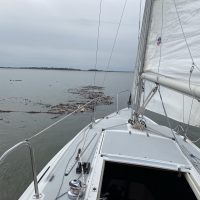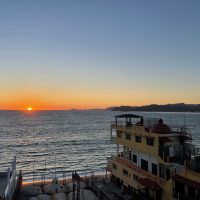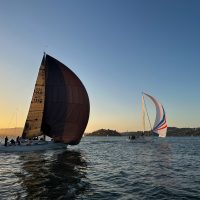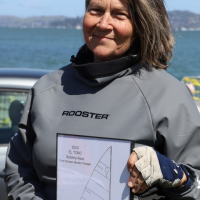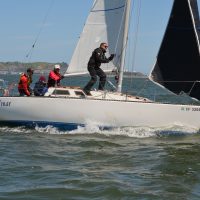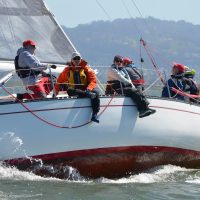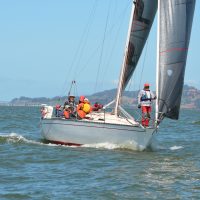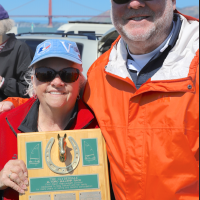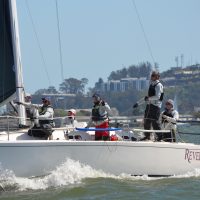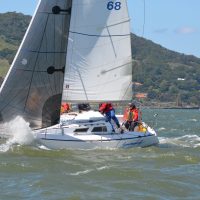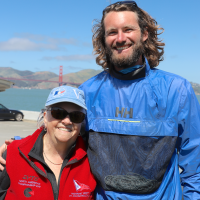
Sir Russell Coutts, SailGP and the Razor’s Edge
SailGP’s foiling catamarans can sail at about three times the speed of the wind. Top speeds are now about 54 knots. New rudders currently in production might get them to 56 knots, and future foils might get them to 60 knots. At these speeds, each crossing is a close shave. Russell Coutts, the founder and CEO of SailGP, says that’s fast enough. Sir Russell Coutts spoke at the St. Francis Yacht Club Wednesday Yachting Luncheon to give members and guests a preview and insights into this coming weekend’s SailGP Final, to be held Saturday and Sunday on the Cityfront.
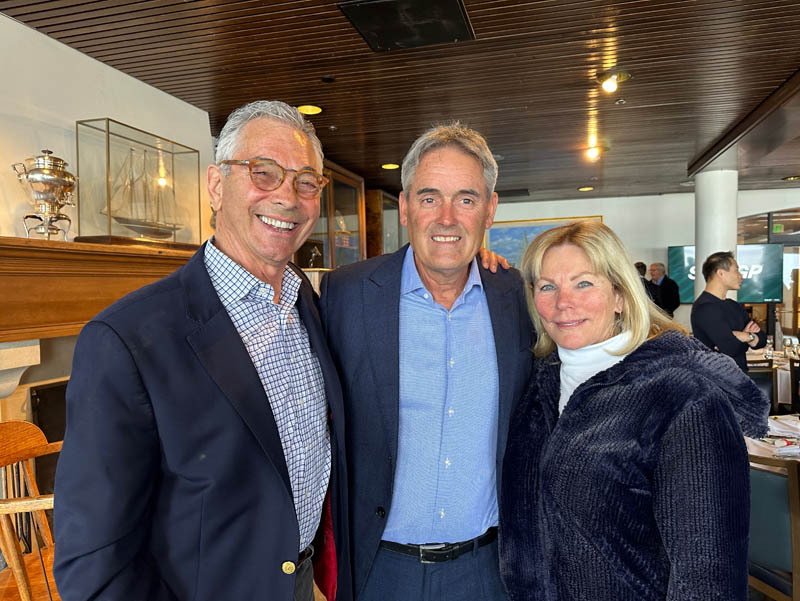
SailGP league has come a long way since season one. The league has survived and thrived despite daunting hurdles. All outdoor events face weather problems, but stadium sailing on TV requires some consistent action despite the fickle nature of wind and weather and occasional crashes and calamities — like the hurricane-force winds at the Australia event that blew up much of the base.
The development of wings and foils has allowed the racing to stay on the water and maintain excitement across a broad spectrum of wind conditions. The traveling circus has learned to travel the globe with nine teams of foiling boats and assemble premier event sites at the water’s edge with increasing abilities and efficiency. And the crowds are growing. You can now view SailGP events in 200 territories.
The audience has grown into the millions and, according to Coutts, the data shows perhaps 80% of them have never stepped onto a sailboat. The average age of viewers is dropping, with an increasing number of 25- and 30-year-old viewers, plus it’s attracting an increasing number of female viewers. The event did garner some rare local attention for sailing in the general media with an article in the San Francisco Chronicle.
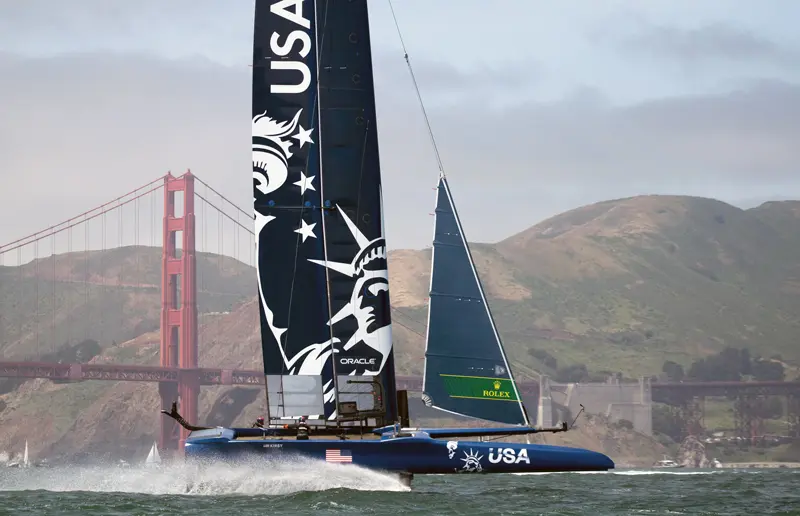
This all plays into a foundational thesis for SailGP that sailing needs a consistently scheduled, high-profile, expertly produced sailing event that is understandable to the masses. Somewhere along the way, the increase in spectators should convert to an increase in participants. To help the public understand, Coutts says, “We have to talk in a language that people will understand.” This brings us back to knots. Though the boats could eventually reach a top speed of 60 knots, the public won’t hear that. They’ll learn the top speed could approach 111 kilometers per hour. Talking in kph vs. knots is controversial for many sailors, but Coutts says the data shows it works, and those of us who never converted our sixth-grade metric lessons into alignment with the rest of the planet are simply out of touch. The guiding principle for commercial success is, “Are viewers interested in watching this or not?” The data is conclusive.
Staying on the edge means if the crew can fly the boat about two inches higher above the water, they can increase the speed by three to five knots. When the foil sections went from 12% to 9% they added about three knots to all the boats. If they fly a couple of inches too high the foils come out of the water and they crash. It’s a delicate balance, but to win they have to sail on the razor’s edge. In fact, the trailing edges of the foils are literally almost as sharp as a razor.
Besides the extreme speeds, the razor’s edge for the whole event is developing a commercial entertainment product that becomes a successful event business, and is sustainable without the support of its founding patron, Larry Ellison. A growing audience and a new 10-year contract with Rolex, with a 10-year option to renew, suggest the foundation is solidifying. Success has allowed the bonus pool for winning to grow to $4.3 million, including the $1 million grand prize that will be awarded on Sunday.
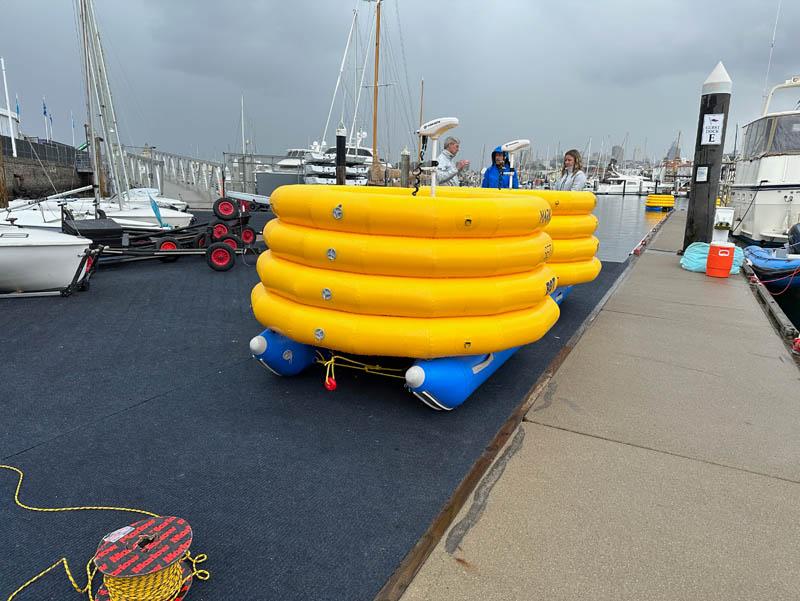
Many other interesting numbers and fun facts came out of the presentation. Like the rest of the world, SailGP has shifted to a more remote workforce. Race Director Ian Murray will be managing the race from his tech office in Australia, where he can oversee the whole race and remote-controlled mark positions from the office. If the wind dies and they need to shorten course he can move the marks on the Bay, from Australia. The umpires sit in an office in London. Data is collected from 800 sensors aboard the boat, so if someone claims they tried to avoid a collision the umpires can just look to see if they actually moved their rudder. Other numbers include the 32 functions needed to perform a perfect tack. And there’s the impact on youth, where SailGP has taken 14,700 young people sailing and hired 415 interns, of whom 150 have joined the sailing industry, 20 are here in San Francisco and 14 have been hired full-time by SailGP. These up-and-coming youth are 50% boys and 50% girls.
The event now claims TV sports news, and sports viewership averages just under 129 million per event, with 122.5 on mainstream news and 6.5 million in sports news and magazines. We liked hearing the mention of magazines and know our readers must be part of that number! The fourth SailGP season will have 12 events, with four in the US, including a new one at the end of July in Los Angeles Harbor. As growth continues, they’re looking toward an annual 20-event season, so fans (and sponsors) can expect to watch an event approximately every two weeks.
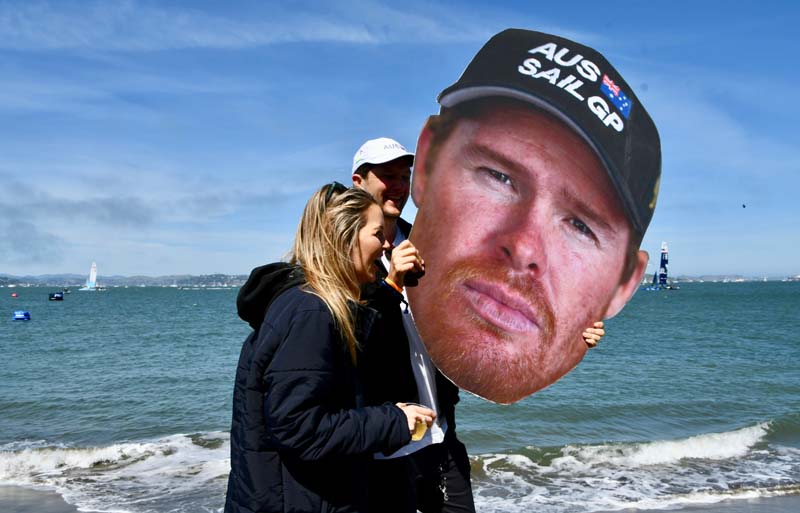
The competition is still all about the teams and their skippers. This weekend’s event is a chance for Tom Slingsby’s Team Australia to win their third title. Barring disaster, they and New Zealand have locked in their spots for Sunday’s $1 million winner-take-all final. Yet Team Australia did damage their wing when they flipped during a practice day, threatening their ability to race. New Zealand is in a solid second, and France and Great Britain are one point apart vying for third.
Russell Coutts is a big fan of Douglas Adams, author of Hitchhiker’s Guide to the Galaxy, whom he quoted, saying, “A learning experience is one of those things that says, ‘You know that thing you just did? Don’t do that.'” As a revered sailor, America’s Cup winner, engineer and now entrepreneur, Coutts is willing to push the razor’s edge. He’s trying new things, courting controversy, and embracing many new learning experiences. It’s very much aligned with the Silicon Valley ethos of launch, learn and iterate. Season three will end on Sunday, and season four will start shortly after in Chicago, on June 16–17.
If you’re a sailor who finds themselves sitting next to a non-sailing fan, perhaps you can help them become a participant rather than a spectator, by explaining the difference between knots and miles per hour. Then invite them sailing, letting them know your boat goes about six knots (6.9 mph / 11/kph) and is safe and relaxing.
It’s Good To Have a Boat Show Back on Our Shores
The Bay Area hasn’t hosted an in-the-water sail and power boat show since spring 2019, and it’s good to finally have one back on the Bay! The Pacific Sail & Power Boat Show opened yesterday at Westpoint Harbor in Redwood City on a day that reminds you of the many reasons outdoor-event planning is hard. Rain the day before and showers yesterday threatened to keep activity at bay, but the return of boats, exhibitors and visitors reminded us all why it’s fun to get together in person and look at the many boats on display.
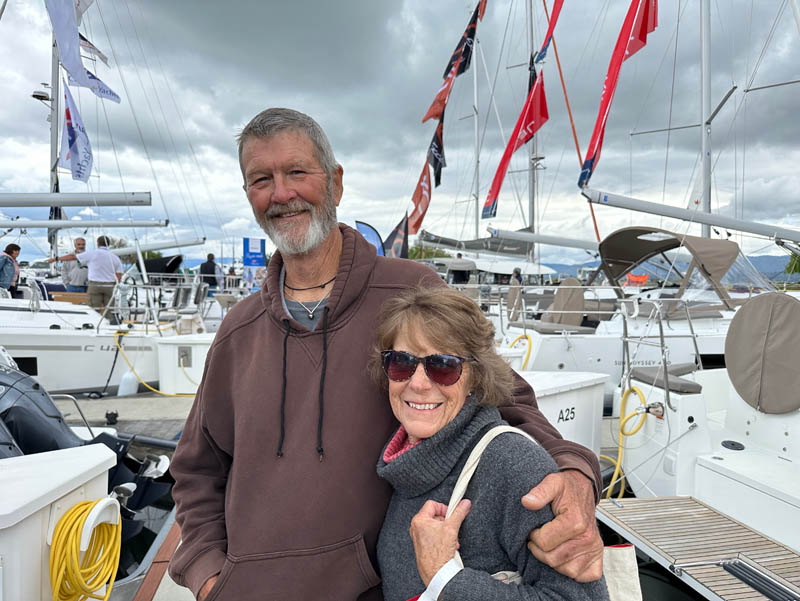
Barry and Samantha Spanier were happy to be back at a show and running into many old friends. They recently launched their scow-bowed 42-ft dream cruiser, Rosie G, drawn by Jim Antrim and built by Cree Partridge at Berkeley Marine Center.
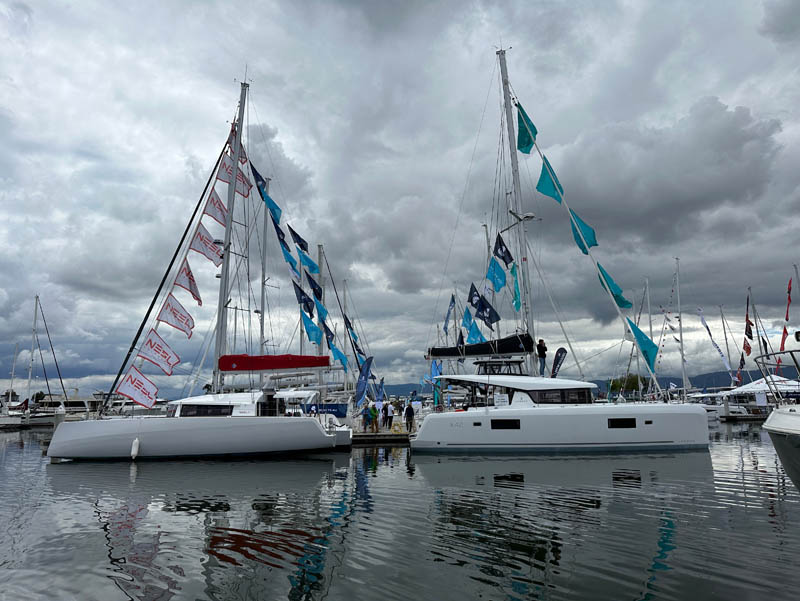
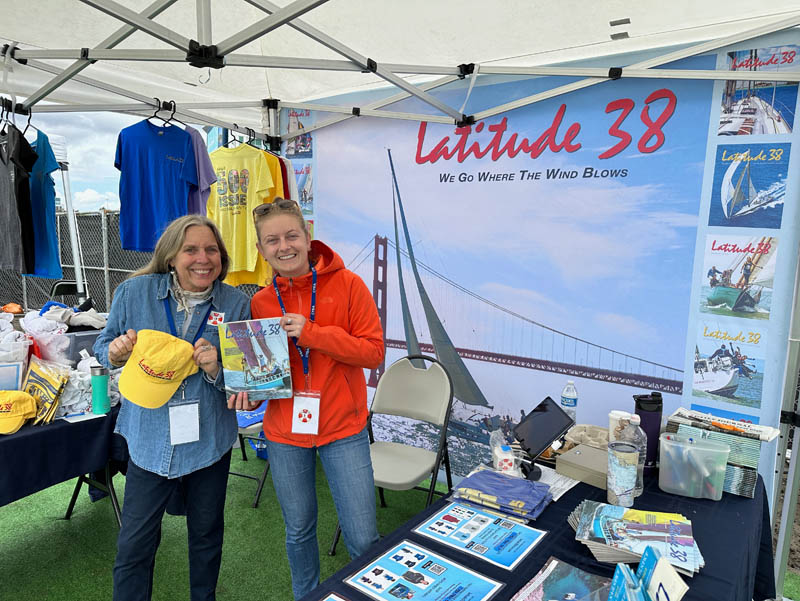
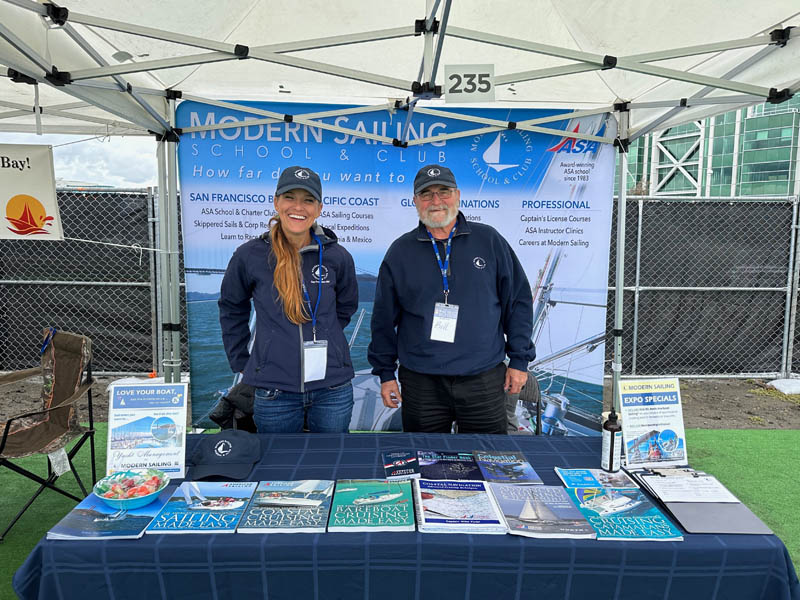
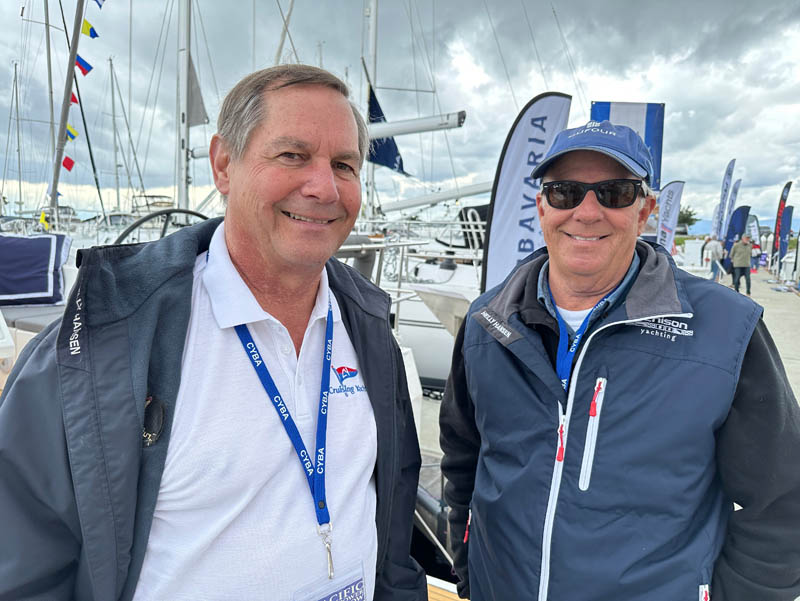
The weather is a little sketchy, but getting together with people again more than makes up for any other resistance to shows. Latitude 38 and many other exhibitors are hosting a post-show Cinco de Mayo party this evening for those who can come by today. The show runs through Sunday. We hope to see you there.
Visit Naos Yachts at the Pacific Sail and Power Boat Show
Meet the San Francisco Bay Naos Yachts team and see the inventory of available boats at the Pacific Sail & Power Show at Westpoint Harbor in Redwood City May 4-7.
Another Singer/Sailor Crosses the Bar: Gordon Lightfoot 1938-2023
Just four months ago we heard the news that singer/sailor David Crosby had crossed the bar. He died at 81, leaving behind a legacy of music that spanned more than just his generation. When we learned this week that Canadian singer Gordon Lightfoot had died on May 1, we were immediately thrown into humming his tune “The Wreck of the Edmund Fitzgerald.” The 1976 release was written about the bulk carrier SS Edmund Fitzgerald, which sank during a storm on November 10, 1975, in Lake Superior. The song is surely known by most sailors (this writer recalls it coming to mind while experiencing her first storm at sea). But what may not be as well known is that Lightfoot himself was a sailor, and after the success of his ninth studio album — Sundown (1974), which hit Number One on the Canadian and US charts — he told reporters at the Detroit Free Press that he would now like to buy a sailboat.
“I would now like to spend more time with each album, each song, and I would also like to get a sailing yacht. Not for competitive sailing, I’m a cruiser. But that’s going to take a lot of time. I’ve got to study navigation and things like that,” the article quotes.
With that newfound knowledge, we set off to learn more about this musician, who, it now appears, was also a sailor. According to a piece we found on Lightfoot’s website, the singer had in his time owned more than one boat. “It was the summer of 1976 when Gordon Lightfoot decided it was time to have the halyards quieted down on his stock 39-footer. The cacaphony they raised when they whacked against the aluminum spar was a bit too much for the ears of this Canadian folksinger, who said he was tired of fiddling around with his old boat.” Understandable. What happened next led him to replace the fiberglass-hulled boat with a wood boat.
Lightfoot had engaged the talents of boat designer Victor Carpenter, who worked under the name Superior Sailboats, to solve his noise problem. In doing so the pair struck up a true sailors’ relationship — they raced each other aboard their current boats: Lightfoot’s 39-ft Sundown, and Carpenter’s 28-ft mahogany-hulled O-Race.
Lightfoot was impressed, and upon returning to shore he looked over Carpenter’s plans for a 45-ft model of the mahogany hull that he had designed some years ago, but never built. “You wouldn’t buy a fiberglass guitar, would you?” Carpenter reportedly shot at Lightfoot as the pair discussed fiberglass versus wood. By the time they were done, Lightfoot had ordered his new sailboat, built of wood, for an “undisclosed sum.” The boat would be called Golden Goose. A little ostentatious perhaps, but if one can, then, why not?
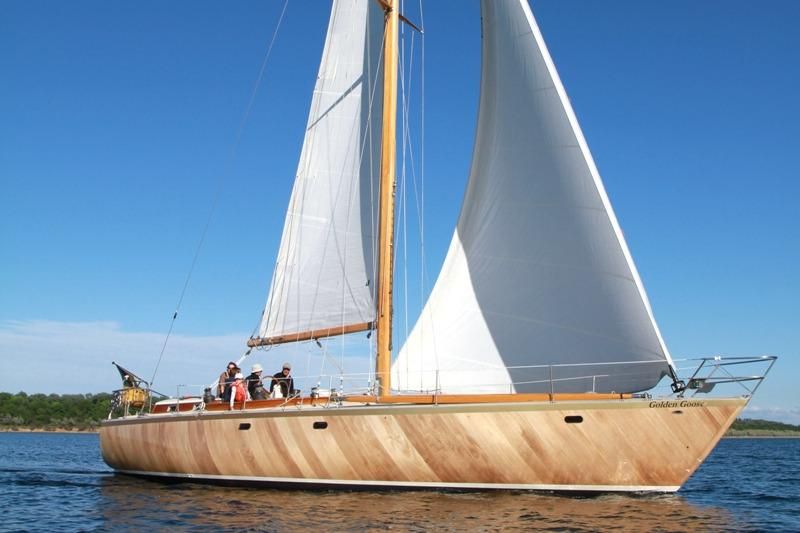
Aside from owning and sailing his boat, Lightfoot drew upon the seafaring life for inspiration for other songs, each of which, in its own small or larger way, reflects some of the nuances of sailing. They include “The Sea of Tranquility,” “Christian Island (Georgian Bay),” “Ghosts of Cape Horn,” and “Ballad of Yarmouth Castle.” We recommend looking them up on YouTube, the Ballad of Yarmouth Castle in particular, as it has a lilting, sailorly vibe that wooden boat aficionados may enjoy.
We realize Lighfoot’s music may not appeal to all audiences, as evidenced by a letter to the editor in Latitude 38‘s January 2012 issue. But personal preferences aside, it’s been an interesting journey learning about Gordon Lightfoot, the singer, songwriter, and mariner. Fair winds, sailor.
Sailagram: A Snapshot of April Sailing
Welcome to April’s sailing photo gallery! Although the month still had some crazy wet weather, we were able to get out on the water a little and enjoy the variety that comes with sailing. If you’d like your photo to be featured next month, send it to us at: [email protected]. Please include photo credit, boat name, hailing port, and any other info you would like to share.


